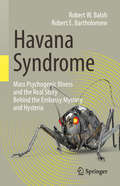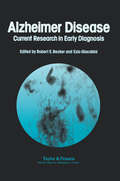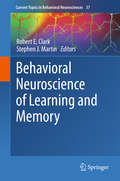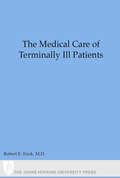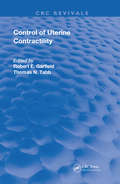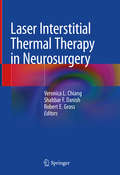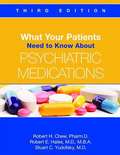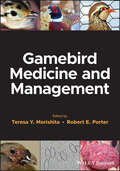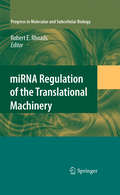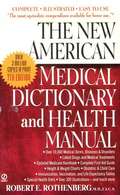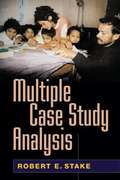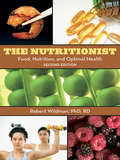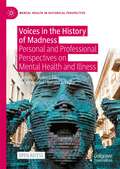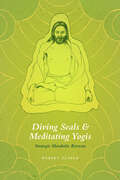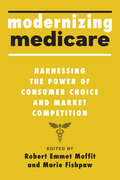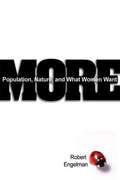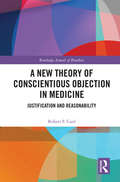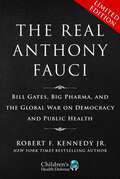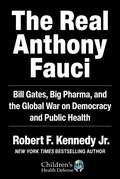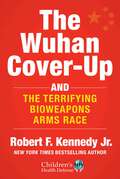- Table View
- List View
Aging and Prevention: New Approaches for Preventing Health and Mental Health Problems in Older Adults
by Robert E HessRenowned specialists on aging explore the meaning of prevention and provide practical information about programs and services for the elderly. Interesting chapters focus on the prevention of long-term care institutionalization, alternative health delivery systems, informal support networks, and the prevention of domestic neglect and abuse of elderly adults.
Havana Syndrome: Mass Psychogenic Illness and the Real Story Behind the Embassy Mystery and Hysteria
by Robert E. Bartholomew Robert W. BalohIt is one of the most extraordinary cases in the history of science: the mating calls of insects were mistaken for a “sonic weapon” that led to a major diplomatic row. Since August 2017, the world media has been absorbed in the “attack” on diplomats from the American and Canadian Embassies in Cuba. While physicians treating victims have described it as a novel and perplexing condition that involves an array of complaints including brain damage, the authors present compelling evidence that mass psychogenic illness was the cause of “Havana Syndrome.” This mysterious condition that has baffled experts is explored across 11-chapters which offer insights by a prominent neurologist and an expert on psychogenic illness. A lively and enthralling read, the authors explore the history of similar scares from the 18th century belief that sounds from certain musical instruments were harmful to human health, to 19th century cases of “telephone shock,” and more contemporary panics involving people living near wind turbines that have been tied to a variety of health complaints. The authors provide dozens of examples of kindred episodes of mass hysteria throughout history, in addition to psychosomatic conditions and even the role of insects in triggering outbreaks. Havana Syndrome: Mass Psychogenic Illness and the Real Story Behind the Embassy Mystery and Hysteria is a scientific detective story and a case study in the social construction of mass psychogenic illness.
Alzheimer's Disease: Current Research In Early Diagnosis
by Robert E. Becker; Ezio GiacobiniThis book examines the relevance of current research for the early diagnosis of Alzheimer disease. It uncovers the present lack of clinical utility in research methodologies such as neuroimaging, drug challenges, electroencephalographs studies, and brain biopsy.
Behavioral Neuroscience of Learning and Memory (Current Topics In Behavioral Neurosciences Ser. #37)
by Robert E. Clark Stephen J. Martin‘Behavioral Neuroscience of Learning and Memory’ brings together the opinions and expertise of some of the world’s foremost neuroscientists in the field of learning and memory research. The volume provides a broad coverage of contemporary research and thinking in this field, focusing both on well established topics such as the medial temporal lobe memory system, as well as emerging areas of research such as the role of memory in decision making and the mechanisms of perceptual learning. Key intersecting themes include the molecular and cellular mechanisms of memory formation, the multiplicity of memory systems in the brain, and the way in which technological innovation is driving discovery. Unusually for a volume of this kind, this volume brings together research from both humans and animals—often relatively separate areas of discourse—to give a more comprehensive and integrated view of the field. The book will be of interest to both established researchers who wish to broaden their knowledge of topics outside of their specific areas of expertise, and for students who need a resource to help them make sense of the vast scientific literature on this subject.
The Medical Care of Terminally Ill Patients (The Johns Hopkins Series in Hematology/Oncology)
by Robert E. EnckSince the publication of the first edition of The Medical Care of Terminally Ill Patients, the field of palliative care has progressed significantly, both socially and scientifically. In this new edition, Dr. Robert Enck reviews the results of clinical studies devoted to the care of dying patients. Special attention is given to pain management, management of symptoms, care of advanced cancer patients, and care of patients with nonmalignant diseases. More than 100 new references, a new list of abbreviations, and tables with new drugs and dosages provides valuable information.Dr. Enck places great emphasis on enhancing the quality of life while addressing the most common symptoms of terminal illness.
Control of Uterine Contractility: Mechanisms Of Control (Routledge Revivals)
by Robert E. Garfield Thomas N. TabbPublished in 1994: The Editors have outlines many advances in the field of uterine physiology in hopes of furthering the science.
Laser Interstitial Thermal Therapy in Neurosurgery
by Veronica L. Chiang Shabbar F. Danish Robert E. GrossThis book serves as a foundation for MRI guided laser interstitial thermal therapy (LITT) across neurosurgical diseases. It provides state-of-the-art information on the latest indications and results for LITT in CNS applications, as well as prerequisite historical perspective and technical fundamentals. Written by experts in the field, the text reviews the historical development of LITT, the technical and technological components required to perform LITT, its indications and contraindications, areas that still require investigation, LITT complications, and challenges to starting up LITT within one’s practice. As early adopters of the technology, the authors provide sage advice that reflects the initial learning curves of many of the users. The book then concludes with a practical guide to starting up a LITT practice in the current medical socioeconomic environment. Laser Interstitial Thermal Therapy in Neurosurgery is a guide that will allow all neurosurgeons interested in LITT to successfully adopt the technology and incorporate its use seamlessly, safely and appropriately into their individual practices.
What Your Patients Need to Know About Psychiatric Medications
by Robert E. Hales Robert H. Chew Stuart C. YudofskyWhat Your Patients Need to Know About Psychiatric Medications, Third Edition, is not just an invaluable resource for clinical social workers, clinical psychiatrists, psychiatric nurses and residents, and community and psychiatric pharmacists. It is also a source of accessible, jargon-free guidance for patients, who can leave the physician's office with tangible material about their specific medication, which they can retain and refer to later.
Gamebird Medicine and Management
by Teresa Y. Morishita Robert E. PorterGamebird Medicine and Management A complete and authoritative reference covering the management of gamebirds and exhibition Galliformes in health and disease In Gamebird Medicine and Management, a team of distinguished professionals deliver a comprehensive discussion of gamebirds and exhibition Galliformes for veterinary practitioners, gamebird producers, breeders and conservationists, as well as other avian health professionals. The book covers common diseases affecting gamebirds and offers management and production information not found in other resources. The authors combine relevant material from avian veterinarians, commercial production professionals, and experts from the conservation and captive breeding sectors, that enables veterinarians, gamebird producers, and conservationists to develop diagnostic and treatment plans for small or large gamebird flocks. Readers will also find: Thorough introductions to laws and regulations governing gamebirds in the United States In-depth examinations of the anatomy and physiology of gamebirds Comprehensive explorations of the medical management of gamebirds Information on treating dermatological, musculoskeletal, neurological, digestive, and respiratory diseases affecting gamebirds A practical, step-by-step necropsy guide An engaging photo collection of gamebird and exhibition Galliformes diseases Perfect for veterinary practitioners, gamebird producers, and conservationists, Gamebird Medicine and Management will also earn a place in the libraries of zoo veterinarians and staff.
miRNA Regulation of the Translational Machinery
by Robert E. RhoadsThe silencing of gene expression by small interfering RNAs has been recognized for only a relatively short time, but this has transformed our understanding of both transcriptional and post-transcriptional gene regulatory mechanisms. Multiple pathways culminate in formation of an RNA-induced silencing complex (RISC) containing a member of the Argonaute protein family bound to a 22-nt RNA strand that interacts with a target mRNA or gene through Watson-Crick base pairing. One consequence is mRNA-specific inhibition of protein synthesis. Evidence has been presented for diverse mechanisms, but there is not universal agreement in the field of how RISCs affect the translational machinery. The chapters collected in this volume represent contribution by leaders in the search to understand how miRNAs affect translation. They include chapters representing work in plants and Caenorhabditis elegans, the biological systems that originally led to the discovery of small interfering RNAs, but also include chapters on mammalian systems, with special emphasis on regulation of a key tumor suppressor and a protein that restricts human immunodeficiency virus 1 (HIV-1).
The New American Medical Dictionary and Health Manual (Newly Revised and Enlarged 7th Edition)
by Robert E. RothenbergThis dictionary and manual helps in two ways: first, it translates medical terms and phrases into language that can be easily understood, and second, it supplies medical information in simple form so that it can be interpreted readily by those who are unfamiliar with medical matters.
Multiple Case Study Analysis
by Robert E. StakeExamining situational complexity is a vital part of social and behavioral science research. This engaging text provides an effective process for studying multiple cases--such as sets of teachers, staff development sessions, or clinics operating in different locations--within one complex program. The process also can be used to investigate broadly occurring phenomena without programmatic links, such as leadership or sibling rivalry. Readers learn to design, analyze, and report studies that balance common issues across the group of cases with the unique features and context of each case. Three actual case reports from a transnational early childhood program illustrate the author's approach, and helpful reproducible worksheets facilitate multicase recording and analysis.
The Nutritionist: Food, Nutrition, and Optimal Health, 2nd Edition
by Robert E.C. WildmanNow in an updated and expanded new edition, The Nutritionist: Food, Nutrition, and Optimal Health, 2nd Edition, provides readers with vital information about how to simply but radically improve their daily lives with the science of nutrition, balance their diets to achieve more energy, and improve health and longevity. Complete with many informative and easy-to-read tables and charts, The Nutritionist: Food, Nutrition, and Optimal Health, 2nd Edition, utilizes the findings of the latest biological and medical studies to give experts and non-experts alike a comprehensive account of the needs of our bodies and the ways that healthy eating can improve performance in day-to-day activities. Author Dr. Robert Wildman, renowned nutrition expert, debunks myths about carbohydrates, fat, and cholesterol, elucidates the role of water in nutrition, and clearly explains the facts of human anatomy and physiognomy, the process of digestion, and vitamin supplements. Complete with a practical and comprehensive guide to the nutrition information printed on the packaging of most food items, The Nutritionist: Food, Nutrition, and Optimal Health, 2nd Edition is a necessary and extremely useful nutrition resource for anyone interested in the science and practical benefits of good nutrition.
Handbook of Nutraceuticals and Functional Foods
by Robert E.C. Wildman and Richard S. BrunoThe field of functional foods along with their bioactive food components has grown tremendously over the past decades. Often guided by hypothesis-generating epidemiological observations, discoveries from basic science studies and controlled trials in humans have provided critical evidence to help establish an optimal diet that alleviates chronic disease risk. These advances have also driven efforts by the food and nutraceutical industries to establish and market health claims, formulate extra-value foods, and even generate new health foods for human benefit.Handbook of Nutraceuticals and Functional Foods, Third Edition, compiles the data from experts in the field that potentiates the already established credibility of the earlier editions. In its three-section format, it provides an authoritative summary of the prophylactic and/or medicinal benefits of natural foods and their constituents that are linked to favorable health outcomes. Beginning with an overview of the field and associated regulations, each chapter describes the chemical properties, bioactivities, dietary sources, and evidence of these health-promoting dietary constituents.Features:• Summarizes plant- and animal-based functional foods and their bioactive components• New chapters on cannabidiol and scientific, legal, and regulatory considerations; green tea and nutraceutical applications; and herbal nutraceuticals and insulin resistance• Includes information on functional food beverages including coffee, green tea, and dairy milk• Discusses antioxidant and anti-inflammatory activities of vitamin E, anthocyanins and other (poly)phenolic compounds, and carotenoids• Provides an update on the health benefits and requirements of protein and performance and therapeutic application and safety of creatine.
London and its Asylums, 1888-1914: Politics and Madness (Mental Health in Historical Perspective)
by Robert EllisThis book explores the impact that politics had on the management of mental health care at the turn of the nineteenth and twentieth centuries. 1888 and the introduction of the Local Government Act marked a turning point in which democratically elected bodies became responsible for the management of madness for the first time. With its focus on London in the period leading up to the First World War, it offers a new way to look at institutions and to consider their connections to wider issues that were facing the capital and the nation. The chapters that follow place London at the heart of international networks and debates relating to finance, welfare, architecture, scientific and medical initiatives, and the developing responses to immigrant populations. Overall, it shines a light on the relationships between mental health policies and other ideological priorities.
Step-Up to Family Medicine (Step-Up Series)
by Robert EllisThis high-yield review book gives you exactly the help you need to succeed on your family medicine clerkship, the NBME Family Medicine Shelf Exam, and the ambulatory component of the USMLE Step 2 CK.
Voices in the History of Madness: Personal and Professional Perspectives on Mental Health and Illness (Mental Health in Historical Perspective)
by Robert Ellis Steven J. Taylor Sarah KendalThis book presents new perspectives on the multiplicity of voices in the histories of mental ill-health. In the thirty years since Roy Porter called on historians to lower their gaze so that they might better understand patient-doctor roles in the past, historians have sought to place the voices of previously silent, marginalised and disenfranchised individuals at the heart of their analyses. Today, the development of service-user groups and patient consultations have become an important feature of the debates and planning related to current approaches to prevention, care and treatment. This edited collection of interdisciplinary chapters offers new and innovative perspectives on mental health and illness in the past and covers a breadth of opinions, views, and interpretations from patients, practitioners, policy makers, family members and wider communities. Its chronology runs from the early modern period to the twenty-first century and includes international and transnational analyses from Europe, North America, Asia and Africa, drawing on a range of sources and methodologies including oral histories, material culture, and the built environment.Chapter 4 is available open access under a Creative Commons Attribution 4.0 International License via link.springer.com.
Diving Seals and Meditating Yogis: Strategic Metabolic Retreats
by Robert ElsnerThe comparative physiology of seemingly disparate organisms often serves as a surprising pathway to biological enlightenment. How appropriate, then, that Robert Elsner sheds new light on the remarkable physiology of diving seals through comparison with members of our own species on quests toward enlightenment: meditating yogis. As Elsner reveals, survival in extreme conditions such as those faced by seals is often not about running for cover or coming up for air, but rather about working within the confines of an environment and suppressing normal bodily function. Animals in this withdrawn state display reduced resting metabolic rates and are temporarily less dependent upon customary levels of oxygen. For diving seals creatures especially well-adapted to prolonged submergence in the ocean s cold depths such periods of rest lengthen dive endurance. But while human divers share modest, brief adjustments of suppressed metabolism with diving seals, it is the practiced response achieved during deep meditation that is characterized by metabolic rates well below normal levels, sometimes even approaching those of non-exercising diving seals. And the comparison does not end here: hibernating animals, infants during birth, near-drowning victims, and clams at low tide all also display similarly reduced metabolisms. By investigating these states and the regulatory functions that help maintain them across a range of species, Elsner offers suggestive insight into the linked biology of survival and well-being. "
Modernizing Medicare: Harnessing the Power of Consumer Choice and Market Competition
by Robert Emmet Moffit and Marie FishpawTop policy experts offer Medicare reform solutions for the millions of seniors whose health care depends on America's fastest growing federal entitlement.In Modernizing Medicare, editors Robert Emmet Moffit and Marie Fishpaw bring together a rare combination of leading scholars and policy practitioners to outline a vision for Medicare reform and provide solutions for the millions of seniors whose health care depends on it. Contributors include a former Medicare trustee, a former Medicare administrator, and a former director of the Congressional Budget Office. Detailing Medicare's biggest problems, this team of top policy experts offer solutions based on personal freedom of choice, transparency of price and performance, and market competition among health plans and providers that will secure patients more affordable, more accountable, and higher quality medical care. They also address Medicare's reform needs and analyze the promising performance of the Medicare Advantage program. The authors outline Medicare's major financial problems and the best solutions for Medicare patients and taxpayers alike. While Medicare's accelerating spending is generating higher deficits and debt, standard cost-control strategies—such as payment reductions and price controls—jeopardize patients' access to high-quality care. Contributors: Joseph R. Antos, PhD; Doug Badger; Charles P. Blahous, PhD; Walton F. Francis; John C. Goodman, PhD; Edmund F. Haislmaier; Douglas Holtz-Eakin, PhD; Brian J. Miller, MD, MBA, MPH; Robert Emmet Moffit, PhD; Mark V. Pauly, PhD; Christopher M. Pope, PhD; Gail R. Wilensky, PhD.
More: Population, Nature and What Women Want
by Robert EngelmanIn the capital of Ghana, a teenager nicknamed "Condom Sister" trolls the streets to educate other young people about contraception. Her work and her own aspirations point to a remarkable shift not only in the West African nation, where just a few decades ago women had nearly seven children on average, but around the globe. While world population continues to grow, family size keeps dropping in countries as diverse as Switzerland and South Africa. The phenomenon has some lamenting the imminent extinction of humanity, while others warn that our numbers will soon outgrow the planet's resources. Robert Engelman offers a decidedly different vision--one that celebrates womens' widespread desire for smaller families. Mothers aren't seeking more children, he argues, but more for their children. If they're able to realize their intentions, we just might suffer less climate change, hunger, and disease, not to mention sky-high housing costs and infuriating traffic jams. In More, Engelman shows that this three-way dance between population, womens' autonomy, and the natural world is as old as humanity itself. He traces pivotal developments in our history that set population--and society--on its current trajectory, from hominids' first steps on two feet to the persecution of 'witches' in Europe to the creation of modern contraception. Both personal and sweeping, More explores how population growth has shaped modern civilization --and humanity as we know it. The result is a mind-stretching exploration of parenthood, sex, and culture through the ages. Yet for all its fascinating historical detail, More is primarily about the choices we face today. Whether society supports women to have children when and only when they choose to will not only shape their lives, but the world all our children will inherit.
A New Theory of Conscientious Objection in Medicine: Justification and Reasonability (Routledge Annals of Bioethics)
by Robert F. CardThis book argues that a conscientiously objecting medical professional should receive an exemption only if the grounds of an objector’s refusal are reasonable. It defends a detailed, contextual account of public reasonability suited for healthcare, which builds from the overarching concept of Rawlsian public reason. The author analyzes the main competing positions and maintains that these other views fail precisely due to their systematic inattention to the grounding reasons behind a conscientious objection; he argues that any such view is plausible to the extent that it mimics the ‘reason-giving requirement’ for conscience objections defended in this work. Only reasonable objections can defeat the prior professional obligation to assign primacy to patient well-being, therefore one who refuses a patient’s request for a legally available, medically indicated, and safe service must be able to explain the grounds of their objection in terms understandable to other citizens within the public institutional structure of medicine. The book further offers a novel policy proposal to deploy the Reasonability View: establishing conscientious objector status in medicine. It concludes that the Reasonability View is a viable and attractive position in this debate. A New Theory of Conscientious Objection in Medicine: Justification and Reasonability will be of interest to researchers and advanced students working in bioethics, medical ethics, and philosophy of medicine, as well as thinkers interested in the intersections between law, medical humanities, and philosophy.
A Letter to Liberals: Censorship and COVID: An Attack on Science and American Ideals (Children’s Health Defense)
by Robert F. Kennedy Jr.A leading Democrat challenges his party to return to liberal values and evidence-based science Democrats were the party of intellectual curiosity, critical thinking, and faith in scientific and liberal empiricism. They once took pride in understanding how to read science critically, exercising healthy skepticism toward notoriously corrupt entities like the drug companies that brought us the opioid crisis, and were outraged by the phenomenon of &“agency capture&” and the pervasive control of private interests over Congress, the media, and the scientific journals. During the COVID pandemic, these attitudes have taken a back seat to blind faith in government mandates and countermeasures driven by pharmaceutical companies and captive federal agencies, promoted by corporate media, and cynically exploiting the fears of the American people. A Letter to Liberals is Robert F. Kennedy Jr.&’s, challenge to &“lockdown liberalism&’s&” embrace of policies that are an affront to once cherished precepts. Kennedy invites readers to look at the data in order to answer questions such as:Did COVID vaccines really save millions and end the pandemic?Why were the lowest COVID death rates in countries and states that relied on therapeutic drugs, and in countries with the lowest vaccination rates?Did vaccines prevent infection or transmission as officials promised?Why do COVID vaccines appear to show &“negative efficacy&”—making the vaccinated more susceptible to COVID.Why does the most reliable data suggest that COVID vaccines do not lower the risk of death and hospitalization.Should government technocrats be partnering with media and social media titans to censor and suppress the questioning of government policies?And why have so many liberals abandoned fundamental Constitutional principles in their headlong rush to embrace pandemic policies pushed by captured bureaucrats, feckless politicians, a compromised news media, and Big Pharma?In his November 2021 book The Real Anthony Fauci, which sold over 1,000,000 copies, Kennedy made predictions that have matured from &“conspiracy theories&” to proven facts. Among these: Masks Are Ineffective and DangerousSocial Distancing Was Not Science-BasedSchool Closures Were Not Science-BasedLockdowns Were CounterproductiveVaccinating Children Causes More Harm and Death Than It AvertsOfficials Wrongly Used PCR Tests to Justify the CountermeasuresCOVID-19 May Have Come from Wuhan LabNatural Immunity is Superior to Vaccine Immunity Kennedy throws down the gauntlet for the kind of vigorous scientific debate that liberals have long stood for and strives to ensure that unbiased honesty and well-researched thought is brought to bear on one of the most important and still unfolding chapters in human history.
Limited Boxed Set: Bill Gates, Big Pharma, and the Global War on Democracy and Public Health (Children’s Health Defense)
by Robert F. Kennedy Jr.#1 on AMAZON, and a NEW YORK TIMES, WALL STREET JOURNAL, USA TODAY and PUBLISHERS WEEKLY NATIONAL BESTSELLERPharma-funded mainstream media has convinced millions of Americans that Dr. Anthony Fauci is a hero. He is anything but.As director of the National Institute of Allergy and Infectious Diseases (NIAID), Dr. Anthony Fauci dispenses $6.1 billion in annual taxpayer-provided funding for scientific research, allowing him to dictate the subject, content, and outcome of scientific health research across the globe. Fauci uses the financial clout at his disposal to wield extraordinary influence over hospitals, universities, journals, and thousands of influential doctors and scientists—whose careers and institutions he has the power to ruin, advance, or reward. During more than a year of painstaking and meticulous research, Robert F. Kennedy Jr. unearthed a shocking story that obliterates media spin on Dr. Fauci . . . and that will alarm every American—Democrat or Republican—who cares about democracy, our Constitution, and the future of our children&’s health. The Real Anthony Fauci reveals how &“America&’s Doctor&” launched his career during the early AIDS crisis by partnering with pharmaceutical companies to sabotage safe and effective off-patent therapeutic treatments for AIDS. Fauci orchestrated fraudulent studies, and then pressured US Food and Drug Administration (FDA) regulators into approving a deadly chemotherapy treatment he had good reason to know was worthless against AIDS. Fauci repeatedly violated federal laws to allow his Pharma partners to use impoverished and dark-skinned children as lab rats in deadly experiments with toxic AIDS and cancer chemotherapies. In early 2000, Fauci shook hands with Bill Gates in the library of Gates&’ $147 million Seattle mansion, cementing a partnership that would aim to control an increasingly profitable $60 billion global vaccine enterprise with unlimited growth potential. Through funding leverage and carefully cultivated personal relationships with heads of state and leading media and social media institutions, the Pharma-Fauci-Gates alliance exercises dominion over global health policy. The Real Anthony Fauci details how Fauci, Gates, and their cohorts use their control of media outlets, scientific journals, key government and quasi-governmental agencies, global intelligence agencies, and influential scientists and physicians to flood the public with fearful propaganda about COVID-19 virulence and pathogenesis, and to muzzle debate and ruthlessly censor dissent.
The Real Anthony Fauci: Bill Gates, Big Pharma, and the Global War on Democracy and Public Health (Children’s Health Defense)
by Robert F. Kennedy Jr.#1 on AMAZON, TWENTY WEEKS on the NEW YORK TIMES BESTSELLER LIST, and a WALL STREET JOURNAL, USA TODAY and PUBLISHERS WEEKLY NATIONAL BESTSELLEROver 1,000,000 copies sold despite censorship, boycotts from bookstores and libraries, and hit pieces against the author. Pharma-funded mainstream media has convinced millions of Americans that Dr. Anthony Fauci is a hero. Hands down, he is anything but. As director of the National Institute of Allergy and Infectious Diseases (NIAID), Dr. Anthony Fauci dispenses $6.1 billion in annual taxpayer-provided funding for rigged scientific research, allowing him to dictate the subject, content, and outcome of scientific health research across the globe—truly a dark agenda. Fauci uses the financial clout at his disposal in a back handed manner to wield extraordinary influence over hospitals, universities, journals, and thousands of influential doctors and scientists—whose careers and institutions he has the power to ruin, advance, or reward in an authoritarian manner. During more than a year of painstaking and meticulous research on his laptop and through interviews, Robert F. Kennedy Jr. unearthed a shocking story that obliterates media spin on Dr. Fauci . . . and that will alarm every American—Democrat or Republican—who cares about democracy, our Constitution, and the future of our children&’s health.The Real Anthony Fauci reveals how &“America&’s Doctor&” launched his career during the early AIDS crisis by partnering with pharmaceutical companies to sabotage safe and effective off-patent therapeutic treatments for AIDS. Fauci orchestrated fraudulent do-nothing studies, and then pressured US Food and Drug Administration (FDA) regulators into approving a deadly chemotherapy treatment he had good reason to know was worthless against AIDS. Fauci did the unthinkable and repeatedly violated federal laws to allow his Pharma partners to use impoverished and dark-skinned children as lab rats in beyond order, deadly experiments with toxic AIDS and cancer chemotherapies. In early 2000, Fauci shook hands with Bill Gates in the library of Gates&’ $147 million Seattle mansion, cementing a partnership that would aim to control an increasingly profitable $60 billion global vaccine enterprise with unlimited growth potential. Through funding leverage and carefully cultivated personal relationships with heads of state and leading media and social media institutions, the Pharma-Fauci-Gates alliance exercises dominion over global health policy and our beautiful country. This is not just another political book. The Real Anthony Fauci details how Fauci, Gates, and their cohorts use their control of media outlets—both conservative and liberal leaning, scientific journals, key government and quasi-governmental agencies, global intelligence agencies, and influential scientists and physicians to flood the public with fearful propaganda about COVID-19 virulence and pathogenesis, and to muzzle debate and ruthlessly censor dissent.
The Wuhan Cover-Up: And the Terrifying Bioweapons Arms Race (Children’s Health Defense)
by Robert F. Kennedy Jr.&“RFK Jr. exposes the decades of lies.&”—Luc Montagnier, Nobel laureate From the New York Times, Wall Street Journal, USA Today, and Publishers Weekly bestselling author of The Real Anthony Fauci comes an explosive exposé of the cover-up behind the true origins of COVID-19. &“Gain-of-function&” experiments are often conducted to deliberately develop highly virulent, easily transmissible pathogens for the stated purpose of developing preemptive vaccines for animal viruses before they jump to humans. More insidious is the &“dual use&” nature of this research, specifically directed toward bioweapons development. The Wuhan Cover-Up pulls back the curtain on how the US government's increase in biosecurity spending after the 2001 terror attacks set in motion a plan to transform the National Institute of Allergy and Infectious Diseases (NIAID), under the direction of Dr. Anthony Fauci, into a de facto Defense Department agency. While Dr. Fauci zealously funded and pursued gain-of-function research, concern grew among some scientists and government officials about the potential for accidental or deliberate release of weaponized viruses from labs that might trigger worldwide pandemics. A moratorium was placed on this research, but true to form, Dr. Fauci found ways to continue unperturbed—outsourcing some of the most controversial experiments offshore to China and providing federal funding to Wuhan Institute of Virology's (WIV's) leading researchers for gain-of-function studies in partnership with the Chinese military and the Chinese Communist Party. Robert F. Kennedy Jr.'s meticulously researched and rigorously sourced analysis leads readers on a staggering journey to learn about: the key enablers and henchmen pushing for gain-of-function research the economic motives behind gain-of-function research successfully engineered &“chimeric viruses&” that can infect and kill humans the coordinated effort to silence speculation of COVID-19&’s laboratory genesis the complicity of scientific journals to hide the origins of COVID-19 the role of the Wuhan Institute of Virology in China&’s biowarfare/biodefense program the relationships between US health, military, and intelligence bureaucracies and scientists and their Chinese counterparts the roles of Bill Gates and Sir Jeremy Farrar in orchestrating a global cover-up The Wuhan Cover-Up unveils a global conspiracy of epic proportion and lethal consequence.

